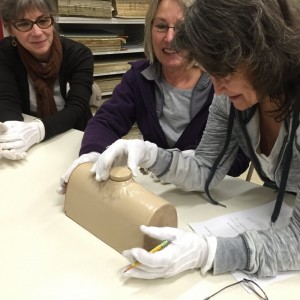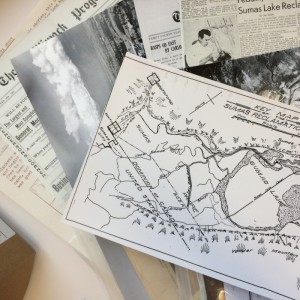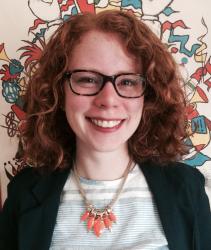Listening to and connecting with teachers is an important part of my job as I develop new educational programs and resources.
This past Friday we hosted a Professional Development day for SD33 teachers. We were not only able to share our knowledge and resources, but learned more about the needs of teachers as well. This kind of collaboration is exciting for us as I aim to make our resources meaningful and useful to educators.
Professional Development

Teachers practice artifact interpretation at the Chilliwack Museum and Archives.
It’s a new year, new curriculum and by hosting a Pro-D day we helped teachers dive into place-based learning and explore opportunities to connect to Chilliwack’s history in their classrooms. I met teachers who have been integrating place-based learning into lessons for years as well as those that are relatively new to building lessons using local content. Most were unfamiliar with the wealth of resources the museum and archives has to offer.
The day started at the archives where Jane and Shannon introduced the teachers to the work of a curator and archivist. This included a tour of our collection. Every single one of our artifacts has a story to tell about Chilliwack and the people who have lived here, Jane told the teachers as they explored the collection. Shannon gave an introduction to our archival collection, including an intro to the online Chilliwack Progress search tool – an invaluable resource for both teachers and researchers. Using an artifact interpretation guide, the teachers were then able to practice their inquiry skills while getting to handle and interpret artifacts.

Teachers were able to explore one of five local history kits which included copies of records from our archives.
In the afternoon, we broke into groups and explored local history kits focused on specific topics such as the British Columbia Electric Railway or the 1948 Flood. These kits were pre-prepared using copies of records from our archives. Teachers were given a chance to interpret the material and then discussed how these topics and materials could be used in classroom teaching. One teacher suggested using a BCER ticket as a quick math exercise asking, how much would it have cost to go from Yarrow to Chilliwack? What a great way to integrate a local topic into a math lesson! There are so many opportunities to use place-based learning in all subject areas. We were only able to begin scratching the surface, but I am looking forward to further exploring the possibilities!
We’re hoping to further develop these local history kits and make them available for teachers to use in the classroom. Using primary sources in teaching, whether it is an object that students can handle, a newspaper article or a railway ticket, is a great way to get students interested and involved in a topic.
Are you a teacher or educator working in the Chilliwack area? If you have any questions about how the Museum and Archives can help support you in bringing place-based content into your teaching feel free to contact me at stephanie@chilliwackmuseum.ca.


Comments are closed.